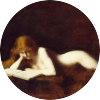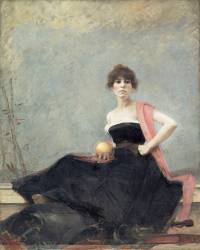
academism fine art prints and canvas prints
Academism refers to academic painting, also called "official painting". These terms refer to an artistic production that is part of an official framework, which formally respects the teachings of academies or official institutions. From the end of the 17th century, the art world was governed by institutions. In 1648, the Royal Academy of Painting and Sculpture was created at the instigation of the French painter Charles le Brun. It replaced the guilds that were responsible for supervising artists. In 1666, Jean-Baptiste Colbert and Charles le Brun created the Académie de France to facilitate the stays and training of French painters in Italy. Finally, in 1673, the first Salons were organised, then called Salons de l'Académie Royale des Beaux-Arts. They quickly became the place to exhibit the works of the Academy's students. Academicism developed in parallel with realist and naturalist tendencies, embodied by Jean-François Millet's Vanneur painted in 1848. The presentation of this work at the Salon caused a scandal. A peasant, a trivial character from the lower strata of society, was set up as the model for the painting, the sole subject of the picture. Academism endorses certain principles of neo-classicism. It established history painting as the "great genre". This very strict hierarchy of genres in painting, which places history painting at the top of the pyramid and still life at its base, is specific to the Academy. The works are also characterised by a strong theatrical dimension and marked by a strong return to antiquity. Academism has often been denigrated by posterity. It was often called "fireman's painting", perhaps in reference to the firemen present at the Salons.
famous academism painting artworks
The main representatives of academism are Jean-Léon Gérôme, William Bourguereau and Alexandre Cabanel. Jean-Léon Gérôme was born in 1824 and died in 1904. In 1846, he produced the major work "Young Greeks Beating Cocks". The painter chose to depict a trivial scene: two naked young figures stand at the foot of a fountain and watch the confrontation between the two gallinaceans. The subject of the work comes from Antiquity. Jean-Léon Gérôme also painted a gladiator scene in Pollice Verso in 1872. William Bourguereau, another ambassador of academism, painted the Oréades, an ascending tornado of nymphs, in 1902. The Oreads are nymphs who live in mountains and caves and are frequently associated with the goddess of the hunt and the moon Diana. Finally, Alexandre Cabanel presented his major work The Birth of Venus at the 1863 Salon. This painting, which brought him great success, was also heavily criticised by the modernists. Emile Zola said of Venus that she resembled "a kind of white and pink marzipan". The Romans of Decadence, a large history painting by Thomas Couture in 1847, is a manifesto of academicism. The painter depicts a subject from a text by the late first- and early second-century poet Juvenal. In an ancient architecture, and under the gaze of the statue of General Germanicus, the viewer witnesses the end of an orgy.
Our academic style art prints will bring a touch of elegance to your decoration. Muzéo offers a selection of pictorial works by academic painters for the greatest art lovers in the form of paintings, cushions, wallpapers or lampshades. All our art prints are handmade by craftsmen proud to preserve the spirit of the work.
You are looking for...
- 30% !
Make good deals by browsing our Reserve : editions of our catalog which await their purchaser at a low price.









































